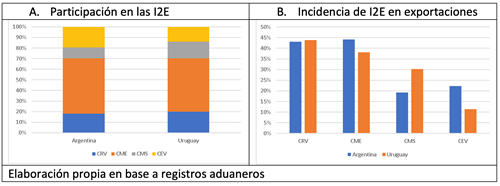Geography of Value Chains in Argentina and Uruguay
November 18, 2022

With the reduction in tariffs and other trade costs, production chains have become global, with different parts of the production process taking place in different countries of the world. Trade in inputs became more relevant, allowing companies from different countries to focus on the production of the goods for which they are most competitive, leveraging the expansion in market access provided by international trade. This prompted the more in-depth analysis of these productive chains with the aim of identifying their contribution to development.
Understanding the different aspects of these productive chains, from the intensity of their insertion in international trade to their geographical coverage, allows researchers and bureaucrats to better understand the potential (positive or negative) effects of different measures that affect their development, from the signing of trade agreements to investment in transport infrastructure or the implementation of trade facilitation measures.
In “Imports for export and global value chains in Argentina and Uruguay”[1] we study the international insertion of exporting companies from Argentina and Uruguay, using data from customs records of companies that used temporary import regimes, which show the origin of imports and the destination of exports. Based on these data, we classify the productive chains into four. Regional value chains (CRVs) are production processes that import inputs from the region for export into the region.
Mixed input chains (CME) are processes that import inputs from countries outside the region and export their production to countries in the region. Mixed output chains (CMS) are processes that import inputs from the region to export their production to countries outside the region. Lastly, extra-regional value chains (VCAs) are production processes that import inputs from extra-regional countries and export production also to countries outside the region.
Panel A of the graph shows the share of the chains that use the regime for Argentina and Uruguay in the period 2017–2019. As can be seen, in both countries regional exports (CRV and CME) are more important than extra-regional exports, with a combined share close to 70%. Moreover, within the latter, there is a larger proportion of CMEs, which shows the importance of extra-regional linkages to promote exports to the region.
In turn, panel B of the graph shows the impact of temporary imports on the value exported. Temporary imports have a higher incidence in CRVs or CMEs (above 40% in the case of Argentina and a slightly lower in Uruguay), which supports the hypothesis that an important portion of the exported value is added in locations close to the place of final consumption, i.e., the region.
The analysis of the sectoral breakdown shows that in Argentina the sectors of land transport equipment and base metals and their manufactures have the largest share in exports that use the temporary import regime (both via CRV and CME). Within the manufactures of agricultural origin (MOA) the fur and leather sector presents greater chains, although in this case related to CEV.
For Uruguay, apart from land transport equipment, the plastics and their by-products and chemicals and related sectors show the highest use of regional and extra-regional imported inputs in their regional exports. Within the MOAs, the fur and leather and dairy sectors show the largest chains, also with a significant participation of CEV.

Based on the analysis, we can conclude that access to imported inputs is vital in the process of integration into regional and global value chains of companies in Argentina and Uruguay. In particular, for certain sectors within manufactures of industrial origin such as the land transport machinery sector, the value of imports represents an important portion of the value of exports, which proves the importance of these inputs in the production of exportable products in these sectors.
The geographical analysis suggests that access to imported products is essential to leverage the opportunities offered by the regional market that is currently free of tariffs, since an important part of exports to these destinations used imported inputs, and a significant proportion of these come from extra-regional origins, which suggests the relevance of mechanisms such as temporary imports that underpin the open regionalism strategy.
[1] See Allub, Garibotti, Lalanne and Sanguinetti (2022) “Importaciones para exportar y cadenas globales de valor en Argentina y Uruguay”.

Lian Allub
Economista Principal, Dirección de Investigaciones Socioeconómicas, CAF -banco de desarrollo de América Latina-
Latest news:
-
Bahamas, Dominica and Grenada to join CAF
March 07, 2024
-
Latin America propose solutions to gain global relevance
January 31, 2024
-
CAF will gather more than 35 international experts at its Conference
January 26, 2024
